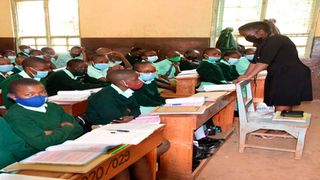
Class eight pupils in class being taken through lesson by their teacher at Kakamega Primary School in Kakamega town on July 26, 2021.
| Isaac Wale | Nation Media GroupEducation
Premium
New tough rules for schools
The Ministry of Education has released tough guidelines on establishment and registration of new schools in line with the requirements of the Competency Based Curriculum (CBC).
Under the new guidelines, pre-primary classrooms are expected to be at least six-by-eight metres and should hold a maximum of 25 learners, while primary-school, junior and senior secondary school classes should have a maximum of 45 learners and measure at least eight-by-nine metres.
“All senior secondary schools must have adequate facilities to offer at least two pathways,” the guidelines seen by the Nation read in part.
Special needs
Special Needs Education institutions should have a maximum of 10 pupils in the case of learners with physical, visual and hearing impairment while, for learners with severe disabilities, the number should be between one and five per class.
Basic Education Principal Secretary Julius Jwan said in order to ensure standards set by the Ministry of Education are adhered to, all institutions wishing to offer education services must abide by the set guidelines.
“The guidelines have been reviewed to ensure schools adopt the 2-6-6-3 system that is currently being implemented in the country,” said Dr Jwan.
A month ago, the PS stopped registration of new schools pending the release of the guidelines.
This was after it emerged there was uncontrolled registration of new institutions, some with poor infrastructure while others were being established on tiny pieces of land, leading to congestion.
Education Cabinet Secretary George Magoha also warned against construction of illegal schools by politicians, who later go seeking approval from the ministry.
The new regulations stipulate that new public basic education institutions in densely populated areas should not be less than 600 metres apart.
Densely populated areas
Pre-primary centres attached to primary schools should be constructed within a 2km radius of the parent institution, the regulations state.
To establish a new public primary school in a densely populated area, any existing ones should have at least two streams and a minimum of 480 learners.
To establish a new public secondary school, nearby public primary schools must have three streams and a minimum population of 540 leaners.
“In densely populated and Asal areas, the nearest existing institutions should have at least 60 learners,’ read the guidelines.
Schools with standalone Pre-primary One and Pre-primary Two centres must be situated on at least 1/8 of an acre in urban areas, ¼ acre in densely populated rural areas and one acre for densely populated rural areas.
Pre-primary One and Two, as well as Grades One, Two and Three must have at least half an acre in urban areas, one acre in rural areas while those with Pre-primary One, Two and Grades One, Two and Three must be at least ½ an acre in urban areas, one acre in densely populated rural areas and four acres for sparsely populated rural areas.
Institutions with primary and junior secondary schools must be built on not less than an acre in urban areas and four acres in rural areas, while those with junior secondary only – especially in the case of private schools – must also be built on at least one acre in urban areas and three to five acres in rural areas. Those with junior and senior secondary schools must also have at least one acre in urban areas and five to six acres in rural areas.
Whole schools – running from pre-primary to senior secondary school – should be built on at least three acres in urban areas and six acres in rural areas, while teacher training institutions must be built on at least 15 acres.
Alternative Provision of Basic Education and Training (Apbet) schools, which are mostly found in informal urban settlements, are now required to be built on at least a half-acre.
The guidelines specify there will be one-year provisional registration and a five-year registration.
Private schools will henceforth be required to pay for a one-year provisional registration or a five-year registration fee of Sh10,000, while registration of public institutions will attract a Sh2,000 fee.
Playgrounds
The regulations also require all learning institutions to have playgrounds measuring at least 90-by-120 metres. Those without playgrounds will be required to lease them within a 200-metre radius from the schools.
All schools are also required to have a non-penetrable fence enclosing all sides of their compounds and have firefighting equipment.
Further, the schools must have toilets or pit latrines and a constant supply of clean and safe water.
Boarding schools will be required to have at least a dormitory for each gender, adequate ablutions, well-ventilated and clean kitchens, food stores and spacious dining areas.





